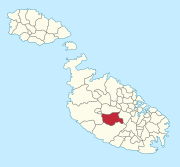Żebbuġ
| coat of arms | map |
|---|---|

|
|
| Basic data | |
| State : | Malta |
| Gzejjer : | Malta Majjistral (Northwest Malta) |
| Distretti : | Western film |
| Area : | 8,659,844 km² |
| Residents : | 12,239 (December 31, 2018) |
| Population density : | 1413 inhabitants / km² |
| ISO 3166-2 : | MT-66 |
Coordinates: 35 ° 52 ' N , 14 ° 26' E
Żebbuġ [ zɛbˈbʊːt͡ʃ ] (or also: Ħaż-Żebbuġ ) is one of the oldest cities in Malta .
History and origin
The parish church is dedicated to Philip of Agira, whose name festival is celebrated on the 2nd Sunday in June, although it actually falls on May 12th. The name of the city is the Maltese word for olive. The name comes from the large olive groves that used to be found at the current location of the church and the city center. The city was given the title of Città Rohan in 1777 by the Grand Master of the Order of St. John, Emmanuel de Rohan-Polduc . As was customary at such events, the residents of Ħaż-Żebbuġ built an archway at the entrance to their hometown to commemorate the newly obtained town charter. The archway, called "Il-Bieb il-Ġdid" (New Gate) by the locals, still stands today.
In 1380 a church dedicated to Philip of Agira was built in Casal Zebugi , a piece of land in the middle of the small settlements that had developed during the previous Arab occupation of Malta. These were in particular Ħal-Dwin, Ħal-Muxi and Ħal-Mula, who were united at that time to form the Ħaż-Żebbuġ, which is still known today. Filippo de Catania, "il-Kataniż", a wealthy entrepreneur in Ħaż-Żebbuġ donated part of the St. Philips Church, which was built on his own land. Many years after it became a parish church, this church was replaced in the 17th century by a new building designed by Tumas Dingli. This church houses a wonderful altarpiece by Luca Garnier and two spectacular wall paintings by the well-known Maltese painter of the 18th century, Francesco Zahra of the Favray School. Critics count this among his best works. Among many other treasures, the church has a work of art attributed to Guido Reni and a few others by Antonio Sciortino. The statue of Saint Philip by the sculptor Luigi Fontana was created in 1864 and is considered by connoisseurs to be the most beautiful of this time in Malta.
When Malta was an independent principate under the rule of the Order of St. John , Ħaż-Żebbuġ was one of the most important cities alongside Valletta and Mdina , especially because of the leading corsairs among its inhabitants, and later because of their important role in the cotton industry. The magnificent St. Philip's Church ensures Ħaż-Żebbuġ a prominent place in Maltese history.
The inhabitants of the city, also known as Żebbuġin in Malta , are also known for their business acumen and the following story is told: During the French occupation of Malta (1798–1800), the churches in the villages and towns were looted for Napoleon Pay Campaign. When they heard the French coming, the inhabitants of Żebbuġ opened the main gate of their church wide and hid the gold and silver icons. When the French saw the gates open, they moved on because they thought there was nothing to be gained here. And so the Żebbuġin kept their church treasures.
archeology
Malta is very rich in archaeological sites and Żebbuġ is no exception. An era in prehistoric times was named after this city because stoneware of a hitherto unknown style was found in tombs in an area called Ta 'Trapna . Later finds from around this time were therefore classified as from the Żebbuġ period. A few scattered Punic and Phoenician tombs have been found, as have a small number of wagon tracks and other remains.
today
Ħaż-Żebbuġ is known for its spectacular festivals for the patron Philip of Agira and St. Joseph. There are three band clubs in Ħaż-Żebbuġ, each with their own fireworks production: "St. Philip's Band Club" (founded in 1851, the first in Malta), "De Rohan Band Club" (founded in 1860) and the "12th May Band and Social Club "(founded in 1961).
Ħaż-Żebbuġ is the birthplace of many well-known Maltese personalities, e. B. Mikiel Anton Vassalli (father of the Maltese written language), Dun Mikiel Xerri (patriot), Dun Karm Psaila (Malta's national poet), Antonio Sciortino (sculptor), Lazzaro Pisani (painter), Frans Sammut (leading contemporary writer) and Alfred Chircop ( contemporary painter).
Ħaż-Żebbuġ has a fairly large number of chapels, both in the town and in the surrounding fields.
The acting French ambassador to Malta lives in Ħaż-Żebbuġ .
Sons and daughters
- Giovanni Cefai (* 1967), religious, prelate of Santiago Apóstol de Huancané in Peru
Web links
Individual evidence
- ↑ StatDB of the National Statistics Office Malta , accessed on August 1, 2020

